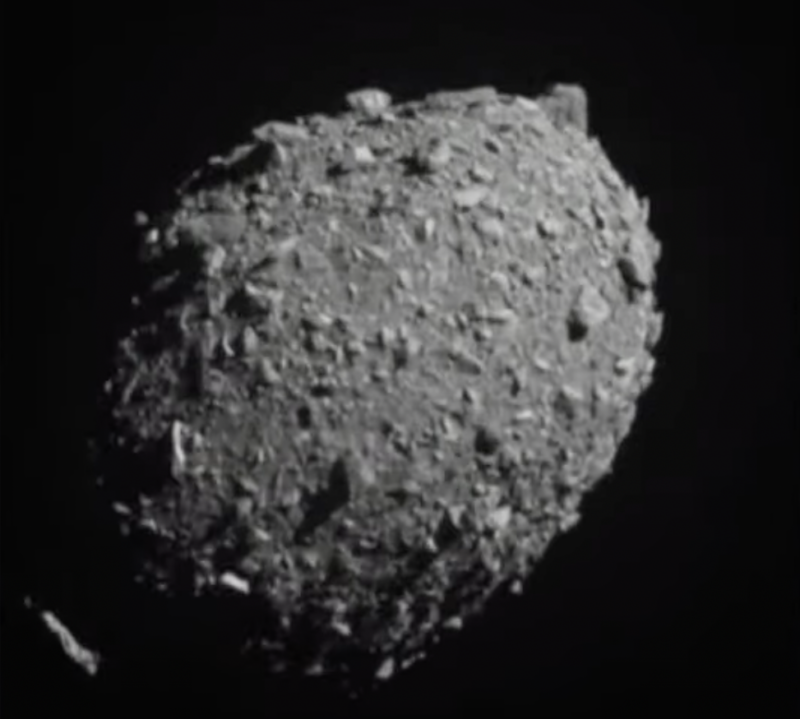
Update, 10:30: If this is an indication of the quality of the images we should expect over the next several days, we’re in for a treat.
ATLAS observations of the DART spacecraft impact at Didymos! pic.twitter.com/26IKwB9VSo
— ATLAS Project (@fallingstarIfA) September 27, 2022
Original article follows.
About 24 hours prior to its collision, NASA’s Double Asteroid Redirect Test (DART) probe performed its last course correction based on commands sent by ground controllers. “It’s pointed to within a football field of the central body,” said Bobby Braun of the Johns Hopkins Applied Physics Lab (APL). “That last maneuver was spot-on.”
Even at this late stage, DART’s onboard camera couldn’t resolve its ultimate target, the small asteroid Dimorphos, so the central body it was targeting is the partner Dimorphos orbits, called Didymos. DART’s onboard navigation couldn’t start navigating toward its target until it could see it, which was only expected to occur about 90 minutes before impact. At that point, the navigation started adjusting DART’s course to get it heading straight at Dimorphos. Ground controllers, separated by about a minute of communications time, could only watch.
“Space is full of moments, and we’re going to have a moment tonight, hopefully,” said Braun.
It all worked. Images from the DRACO camera showed Dimorphos looming ever larger over the last minutes leading up to the collision, eventually filling the entire field of view. And then, in a moment that would normally indicate disaster, transmissions stopped part way through the final image. “What we’re cheering for is loss of spacecraft, so it’s different,” Braun had said earlier in the day.
As for the details of that impact, we’ll have to wait. The best images we’ll get are from an Italian Cubesat called LICIACube that has been trailing DART since the two separated a few weeks ago. LICIACube will be about 50 km from the point of impact and will get even closer over the three minutes after impact before passing behind Dimorphos. But it will take some time to transmit images to Earth—possibly a day or more for processing and release.
So, the first images are likely to come from ground observatories, which are looking for brightening caused by the debris plume spreading from the point of impact. When asked how much ground-based hardware was dedicated to watching for the plume, Cristina Thomas of Northern Arizona University said, “I don’t know, but there’s a lot of them—it’s very exciting to have lost count.” Nancy Chabot of APL said the count was up to three dozen, and they’ll be joined by the Hubble and Webb Space Telescopes. Some of those images are likely to show up online by tomorrow.
The exact details of the debris plume can potentially tell us a lot about the asteroid’s interior, and help us design planetary defense hardware. But that level of analysis will take months, with lots of computer modeling compared to images from multiple sources to try to understand what happened.
NASA is about to hold a press conference about the results, so we’ll see if any details or images released and update this story accordingly.
Update, 8:40 pm: Not a lot of news from the press conference. The biggest bit of information is that there’s a window at just before midnight where LICIACube could send impact images via NASA’s Deep Space Network. It’s not clear whether everything will work out to happen, but that could be the first details we see. Initial estimates are that the impact occurred within 17 meters of the center of the asteroid, but Lena Adams of APL said that the shadow over part of the asteroid made the center a bit difficult to identify.
The other thing that was clear was that the final approach was as clean as it seemed. “i kept telling the people next to me, this is nominal, this is nominal, this is nominal,” said APL’s Ed Reynolds. The team didn’t need to make any adjustments during approach, and felt confident rather than tense as the window closed on their ability to send commands to the spacecraft. As Adams said, “we had planned contingencies, but we didn’t have to do them.”
One minor fact that came out is that there was still significant hydrazine and xenon propellant on board when it hit, which might influence the ejection of debris from the surface.
https://arstechnica.com/?p=1884719

